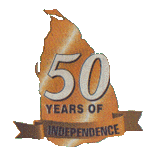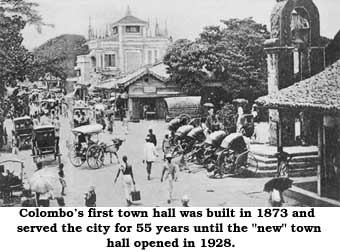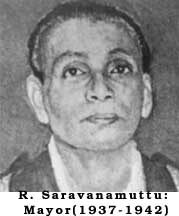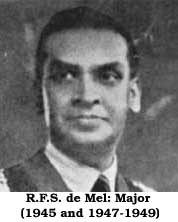

![]()
 The
Colombo Municipal Council (CMC) which has produced Presidents, Prime Ministers,
Ministers and many more VIP's in various other fields is 133 years old.
The Legislative Council of Ceylon in its 1865 Sessions passed a Bill constituting
the CMC which held its maiden meeting on January 16, 1866, with nine elected
and six nominated members, under the Chairmanship of GA. Western province
C.P. Layard. Sir Hercules Robinson (1865 - 72) was Governor.
The
Colombo Municipal Council (CMC) which has produced Presidents, Prime Ministers,
Ministers and many more VIP's in various other fields is 133 years old.
The Legislative Council of Ceylon in its 1865 Sessions passed a Bill constituting
the CMC which held its maiden meeting on January 16, 1866, with nine elected
and six nominated members, under the Chairmanship of GA. Western province
C.P. Layard. Sir Hercules Robinson (1865 - 72) was Governor.
Among other things the CMC was directed to deal with according to the Municipal Ordinance were, conservancy of streets and bridges, providing dust bins and disposal of night soil, housing, legal action to prevent overcrowding considered injurious to health in habitations, making sewers, drains and water lines.
The CMC was also empowered to attend to the maintenance of the above so that they would not be a nuisance or injurious to public health. Maintaining public places, elimination of insect vectors and to provide bread, meat, fish supplies etc were among the duties the CMC had to perform. Future Councils were empowered to introduce any other items that would benefit ratepayers. Safeguarding the health of ratepayers took prominence. Licensing slaughter houses and registration of dangerous and offensive trades were also handled by the CMC.
When the Council was instituted the population in Colombo Fort was only 734 heads, while 4,979 heads were registered in Pettah. Beyond Pettah it was 24475. In 1871, 95,843 lived in Colombo which had an area of 14 square miles, (365 kilometres).
 As
time went on with the increase in population and business activities, the
need to expand the Town Hall which was in Gas Works Street, Pettah, arose.
CMC heads of department suggested various sites for a new building, but
the present location Town Hall was finally accepted.
As
time went on with the increase in population and business activities, the
need to expand the Town Hall which was in Gas Works Street, Pettah, arose.
CMC heads of department suggested various sites for a new building, but
the present location Town Hall was finally accepted.
Government Architect J.G. Smithers created the present Town Hall on paper and even got it constructed under his supervision. Work commenced in 1924. After four years the massive white building was built at a cost of £ 7,000 . Governor T. Reid opened it in May 1928. CMC staff led by Mayor H.E. Newman moved to the new Town Hall. With huge tall pillars and high domes it has been constructed in the Gothic architectural style that prevailed in Europe during the 12th - 16 th centuries.
The Museum building was later built by the same architect. "I have visited many countries and their capitals and the Colombo Town Hall is one of the finest buildings I have seen. We should protect this majestic landmark," former Mayor K. Ganeshalingam remarked at the last CMC Budget meeting.
 Sri
Lanka gained independence fifty years ago during the tenure of Mayor R.F.S.de
Mel (1945 - 1949). The first Sri Lankan Mayor was a Tamil, Dr (Sri) Ratnajothi
Saravanamuttu (1937 - 1942). Dr Kumaran Ratnam (1950), S.Sellamuttu (1951),
T. Rudra (1953) and K. Ganeshalingam (1996) were the other Tamil Mayors
who held this prestigious office.
Sri
Lanka gained independence fifty years ago during the tenure of Mayor R.F.S.de
Mel (1945 - 1949). The first Sri Lankan Mayor was a Tamil, Dr (Sri) Ratnajothi
Saravanamuttu (1937 - 1942). Dr Kumaran Ratnam (1950), S.Sellamuttu (1951),
T. Rudra (1953) and K. Ganeshalingam (1996) were the other Tamil Mayors
who held this prestigious office.
The first Muslim Mayor was M.H. Mohamed (1966). His son M.Hussain Mohamed holds the record of being Deputy Mayor continuously for ten years, before he donned Mayoral robes (1989-1991). The father- son duo, M.H. Mohamed and Hussain Mohamed are the only father-son pair to be first citizens of Colombo so far.
Other Mayors who were at the helm of the CMC since Independence are Dr. V.R. Schoman, A.E. Goonesinha,George R de Silva, R.A. de Mel, C.T. Grero, Dr N.M. Perera, V.A. Sugathadasa, M. Vincent Perera, A.H.M. Fowzie, B. Sirisena Cooray, Ratnasiri Rajapakse and present Mayor Karu Jayasuriya.
During Mayor M. Vincent Perera's term, the CMC celebrated its centenary (1965). Prime Minister Dudley Senanayake was the chief guest. Mr M. Tiruchelvam was Minister of Local Government. A former CMC Commissioner William Gopallawa was Governor General of Sri Lanka. Mayor M. Vincent Perera commissioned several rate payer utility projects such as community centres, dispensaries and road improvement schemes to mark the occasion.
President R. Premadasa was chief guest when the CMC celebrated its 125th anniversary in 1990. M. Hussain Mohamed was Colombo's Mayor. The President presented all Councillors with gold medals in appreciation of their services to Colombo ratepayers. The Lipton roundabout clock tower a replica of the Town Hall dome was constructed to commemorate the event. While the premier local body of the country was celebrating its 125th anniversary the upper portion of the pandal erected at the entrance of Colombo Town Hall near F.R. Senanayake - Dharmapala Mawatha collapsed. An opposition Councillor predicted that it was a bad omen and said the ruling party may not capture power at the elections that were scheduled to be held in 1991. The Councillor's prediction was off the mark as the UNP was returned with a comfortable majority in Colombo at the 1991 Local Government elections. The UNP named Mr Ratnasiri Rajapakse as Mayor while present Transport Minister A.H.M. Fowzie was Opposition Leader. Mr Rajapakse however did not continue his term as Mayor. Deputy Mayor K. Ganeshalingam who was made Acting Mayor has presented three Budgets, which is also a record.
Among the Councillors, C.P. Dias had served the CMC for 36 years (1891 - 1926) while N.H.M. Abdul Cader counts 31 years (1907 - 1938).
With the increase in population the number of Councillors too was increased by successive governments. The wards they were elected to rose from 27 to 31, 47, 51 and 53. Colombo city is presently divided into 47 Municipal Wards. As Municipal elections are now held according to the PR system, these wards are essentially demarcated and identified for the purpose of collection of rates and taxes.
Presently Colombo has a population of a little over 1.2 million. A floating population of nearly 400,000 move about or are employed in Colombo. There is a refugee population also in Colombo and the CMC faces the challenge of providing the necessary basic amenities to them.
Infrastructure facilities provided by the British were meant only for a city population of about 500,000. As Colombo was not developed in keeping with the rise in population, colossal sums of money are needed now to provide rate payers with better living facilities.
Mayor Karu Jayasuriya in his Rs 4.6 billion current Budget has allocated the highest sum for urgent projects to be undertaken with foreign assistance .The two projects are the storm water project Rs 1,128,575,000/- and Solid Waste project costing Rs 780.000,000/-. A sum of Rs 186,000,000/- has been allocated to re-lay Drainage pipes.
A regional urban survey conducted by the Asiaweek in South East Asian countries, rated Colombo the 23rd best city with Fukuoka occupying the first place.
Mayor Jayasuriya is confident that the CMC can deliver the goods, providing solutions to most of the problems of traffic, sanitation, drainage water supply etc. by implementing the 'Mission for Colombo 2005' development programme which commenced recently.
Continue to Plus page 5 * That battle for democracy
Return to the Plus contents page
![]()
| HOME PAGE | FRONT PAGE | EDITORIAL/OPINION | NEWS / COMMENT | BUSINESS
Please send your comments and suggestions on this web site to
info@suntimes.is.lk or to
webmaster@infolabs.is.lk